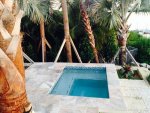You will only get heat for a minute or two after the heater turns off as the water draws off any remaining heat in the heat exchanger. While there is some very minimal heat from friction, it would never be enough to be measurable. Based on your description there must be a heater running at some point even though you say there isn't. Without a heater running you couldn't get the results your describe.
Autofill on an infinite edge pool can get a little bit complex, and is handled in different ways by different vendors.
Assuming the overflow pump has been running recently (say in the last day or two), the main pool will always be at the same height, just below the lip of the overflow edge. You can then use the height of the water in the overflow trough (when the edge pump is not running) as an indication of how much water there is in the entire system. The edge pump will disrupt things a certain amount, lowering the water height in the trough due to the water in transit. So you either lock out the autofill while the edge pump is on, or put some extra capacity in the trough to handle a slightly variable fill level.
Fancier systems measure the water height in both the main pool and the trough, as well as keeping track of which pumps are running, resulting in more consistent results and eliminating the need to run the edge pump daily to get the autofill to work correctly.
If rough-housing can result in overflow, you have very little margin in your trough system, and will be prone to minor problems of one kind or another. In such a system, if the autofill does not lock out during edge pump operation, you would almost certainly lose water at regular intervals as you simply don't have the margin needed for the variability in trough water height.
Saying that the sensor is under the coping is kind of vague. There are several kinds of sensors, with varying approaches to measuring water height. The simplest sensors have a small float at the end of a hinged arm, which could easily extend several inches below the coping to measure fill height. One of the fancier kinds of sensor has an electronic strip that measures water height across the entire height of the strip. You can also have simpler electronic sensors the simply have two pins and can sense if the pins are both in the same body of water, or have an air gap between them. The two pins sensor would need to be mounted on the wall a few inches below the coping.



